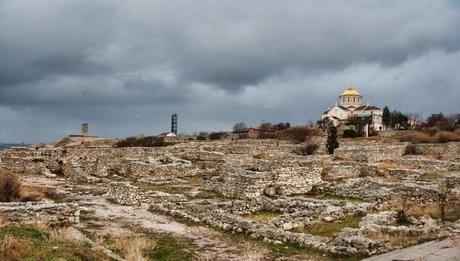Charax
Charax is the largest Roman military settlement excavated in the Crimea. It was sited on a four-hectare area at the western ridge of Ai-Todor, close to the modern tourist attraction of Swallow's Nest.
The military camp was founded under Vespasian with the intention of protecting Chersonesos and other Bosporean trade emporiums from the Scythians. By the end of the 1st century AD, the Roman forces were evacuated from the peninsula. Several decades later the camp was restored by a vexillatio of the Legio I Italica; it hosted a detachment of the Legio XI Claudia at the end of the 2nd century. The camp was abandoned by the Romans in the mid-3rd century.
The ruins of the camp were discovered by Peter Keppen in 1837; he estimated the length of the defensive wall at 185 sazhens (395 meters). Keppen identified the site with Charax (from the Greek word for "fortification"), the only Roman camp recorded in Crimea. Although there is no evidence that Charax was situated near Ai-Todor, the name stuck. Intrigued by Keppen's publication, Count Shuvalov funded the first (and rather amateurish) excavations of the site in 1849.
In 1896 excavations were resumed under the supervision of Grand Duke Alexander Mikhailovich of Russia, who had his summer dacha constructed in the immediate vicitinity of the ruins and the 1865 lighthouse. The excavations lasted for fifteen years and yielded a great number of Roman coins and bronze artifacts. Michael Rostovtzeff, who oversaw the excavations on behalf of the St. Petersburg University, classed Charax as the "entire Roman city", rather than just a fort, as was previously thought. A museum of archaeological finds was opened at Charax in 1907.
Further exploration of the site, undertaken by Vladimir Blavatsky in 1931-35, revealed remains of two public water basins, thermae, and an aqueduct. There were also a gymnasium and a sanctuary outside the walls. Blavatsky and his followers lent their support to Rostovtzeff's theory that the most ancient line of cyclopean walls at Charax was erected by the Tauri before the arrival of Romans, a theory which since lost much of its popularity. They also hypothesized that the castrum had been ruined by retreating Roman soldiers in order to avoid its seizure by the enemy.
These military settlements were often permanent camps built in such a way so as to protect and hold equipment used by the soldiers when they were not in war. This allowed soldiers out in war zones an opportunity at the end of the day to come back to a proper camp with all the equipment and necessities needed to continue and finish the fight successfully.
This particular military site was found in Crimea when the independent republic of Ukraine began excavations here in 1837. The work was done by a man called Peter Keppen. The Roman settlement takes up approximately four-hectares of land and is situated near to Ai Todor. When Keppen first found the remains he did a little research and came to the conclusion that the wall used to defend the camp would have been about 395 meters long. From this wall he concluded that this was a Roman military camp, the first and only one to have been discovered thus far.
Keppen didn't have the resources to be able to carry out this task and instead wrote up a publication publishing his discoveries. It was Count Shuvalov who happened to read this intriguing publication and from then decided to supplement Peter Keppen's excavation costs in 1849. It was later discovered that the Roman Charax was created under the rule of Imperator Caesar Vespasianus Augustus during his rule of Rome from 69 to 79 AD as a means of protection. Later the camp was abandoned but restored again by a Roman legion group used as a task force by the Roman Army. Then in the third century the Roman Charax was deserted again.
Keppen's excavations were not professionally done and not much else was found out about this site. Nearly fifty years went by before excavations began again. This time it was Grand Duke Alexander Mikhailovich of Russia who undertook this large task, finding over the next fifteen years an immense number of treasures which included bronze objects and a large amount of Roman coins. The findings were so successful that a museum was opened holding the immense collection in 1907. It was also discovered that the Roman military settlement was more than just a camp, it was a Roman city. You can get there by direct flight to Simferopol or through Kiev or Odessa.


